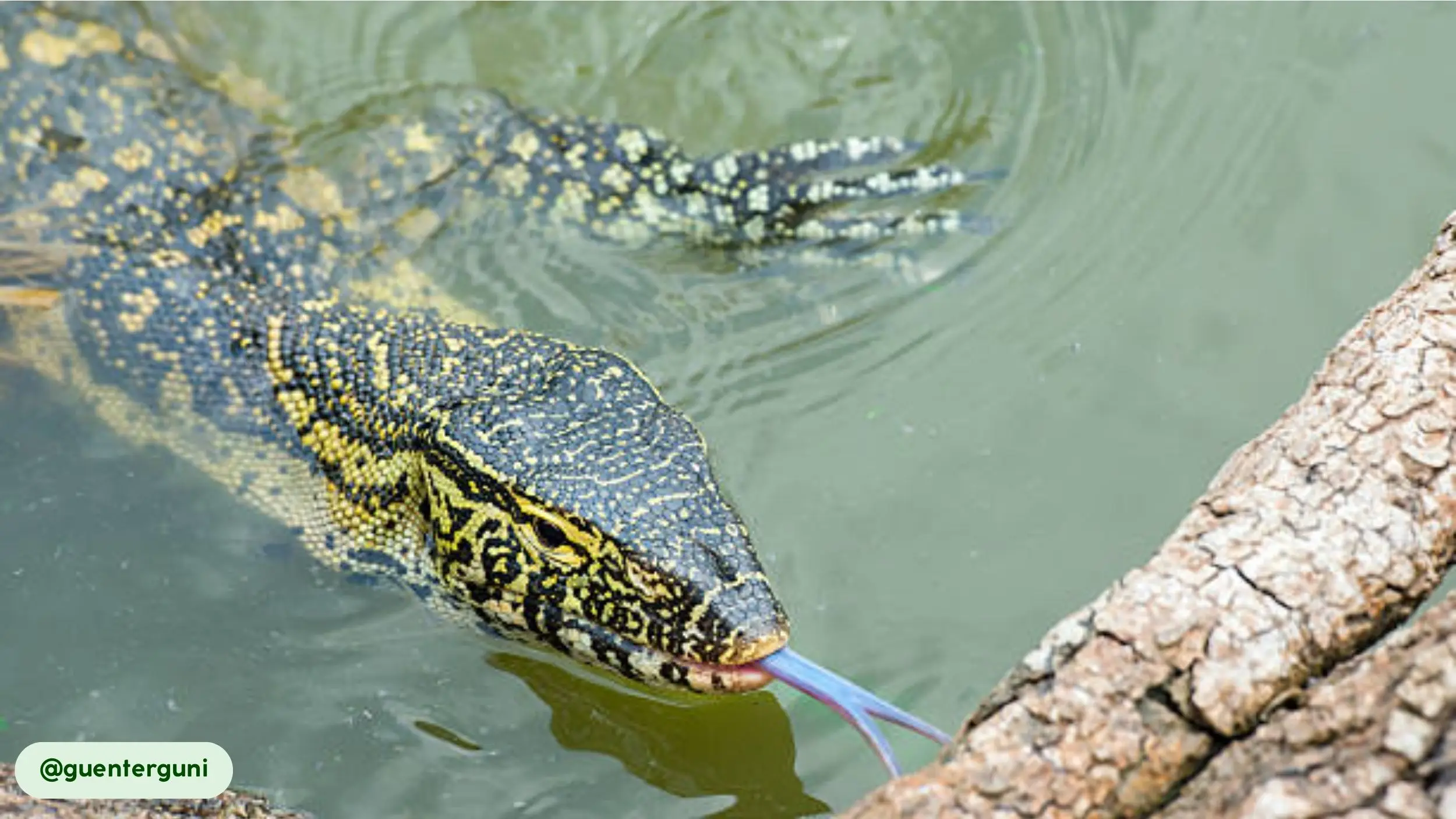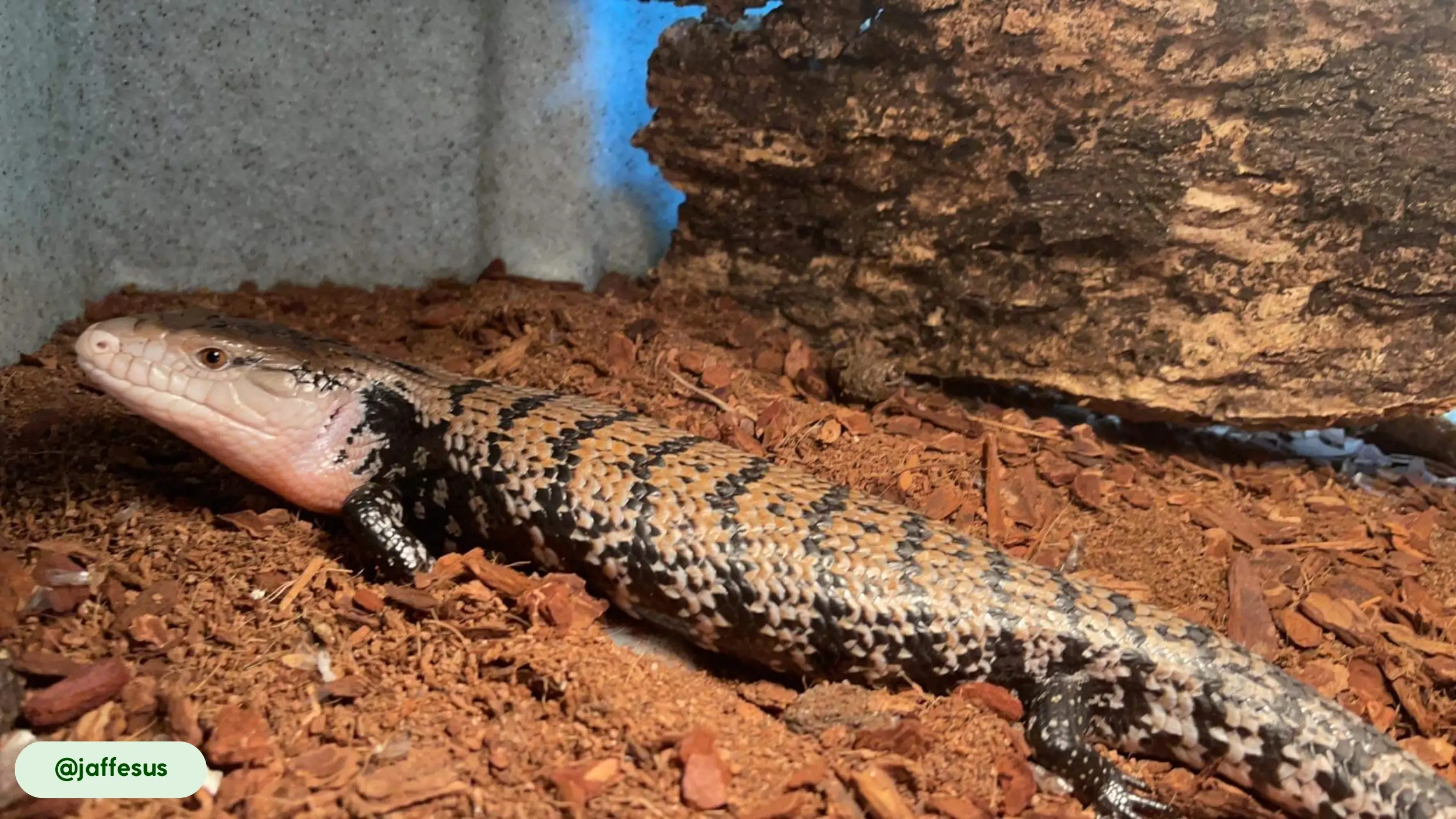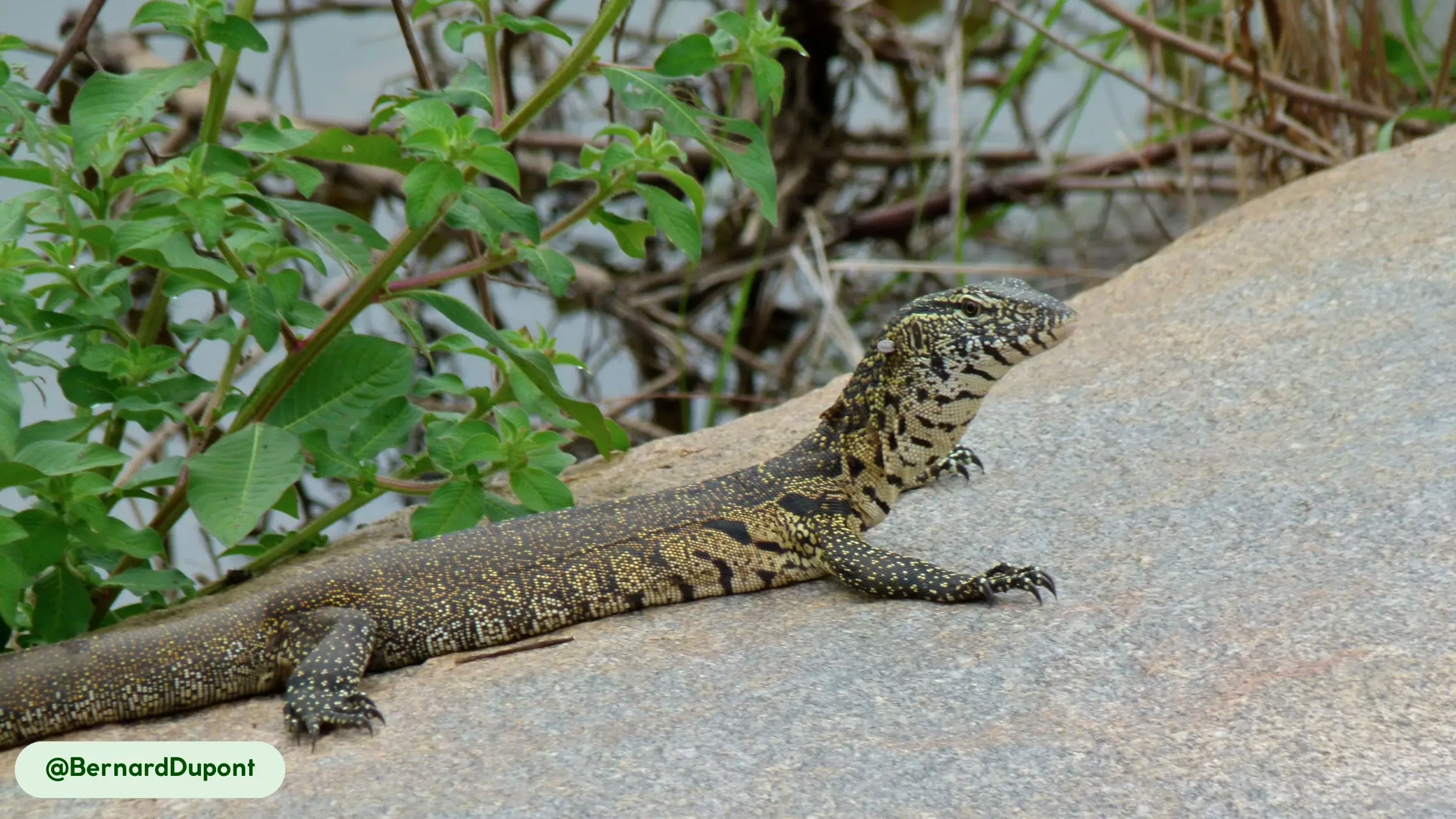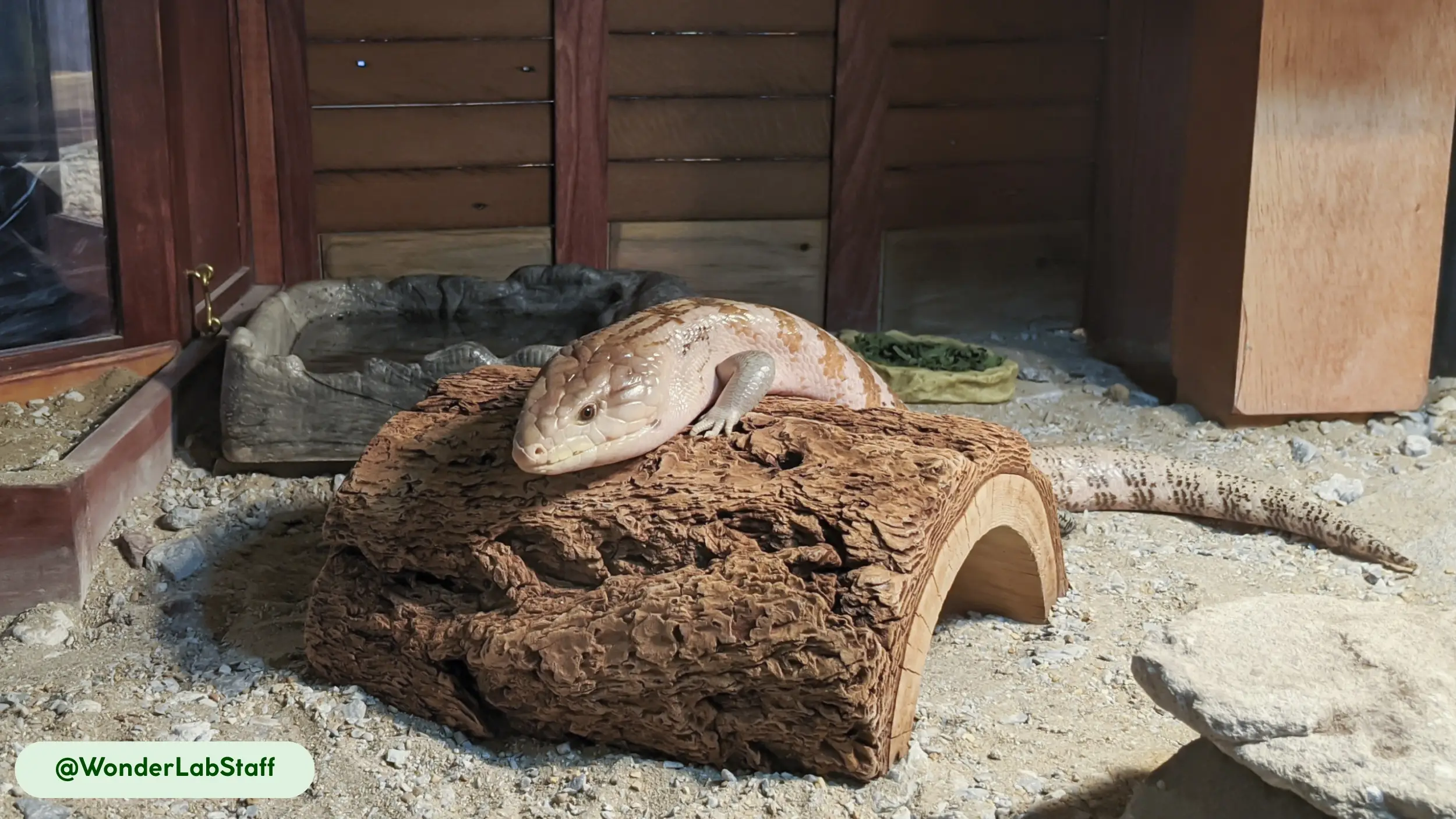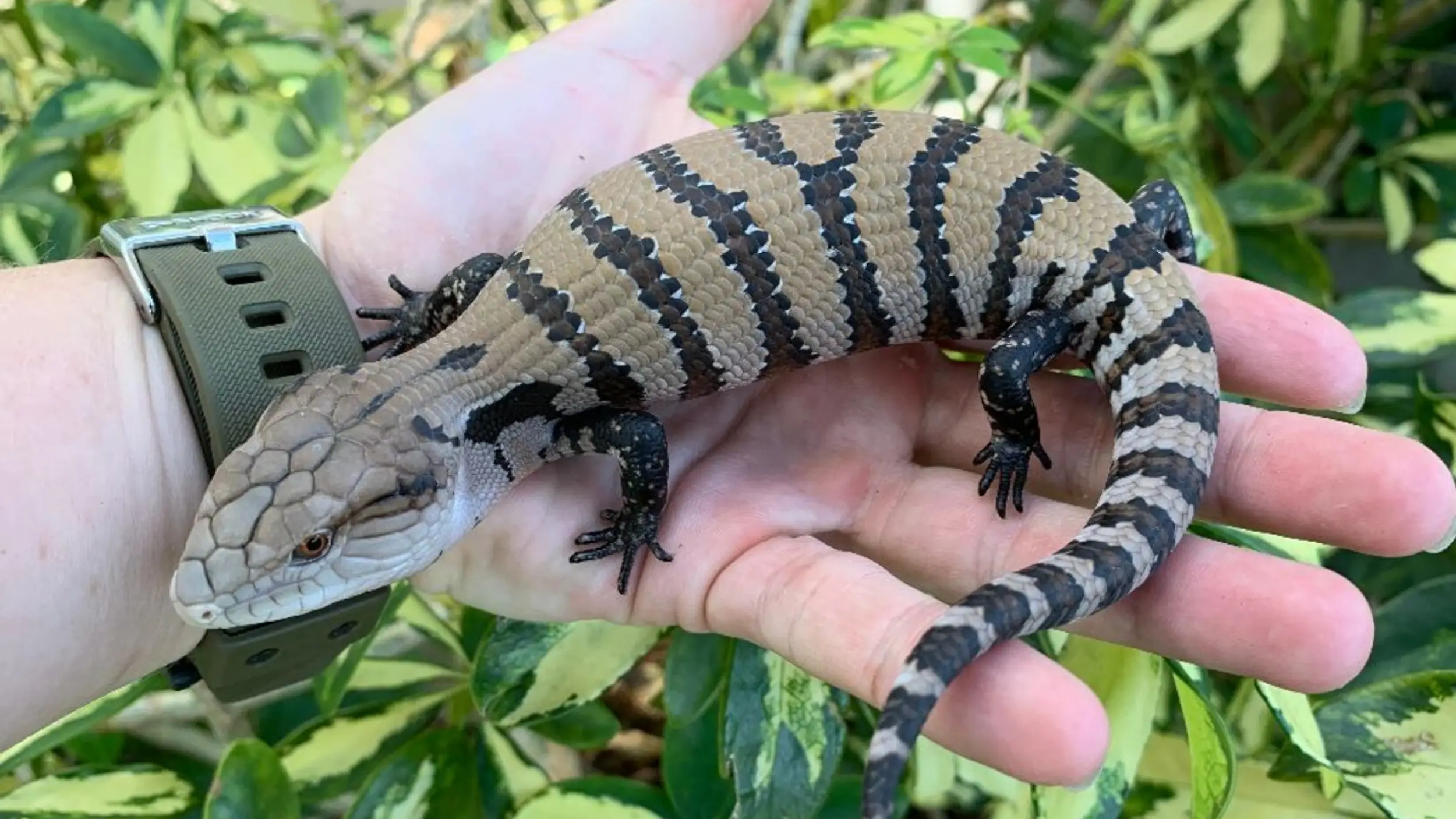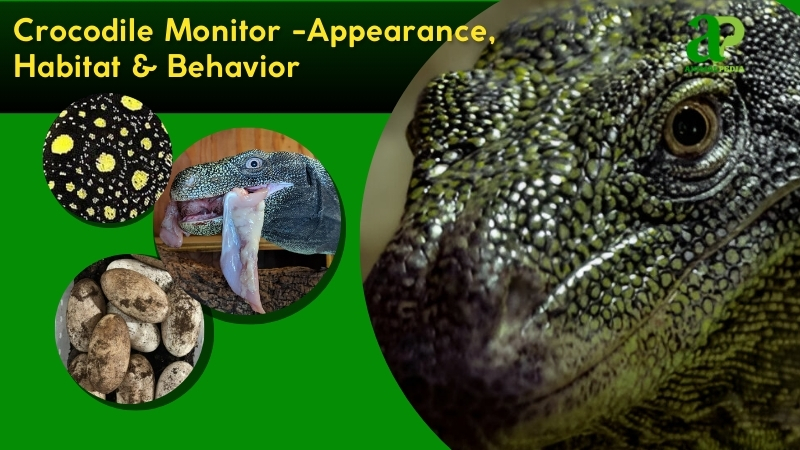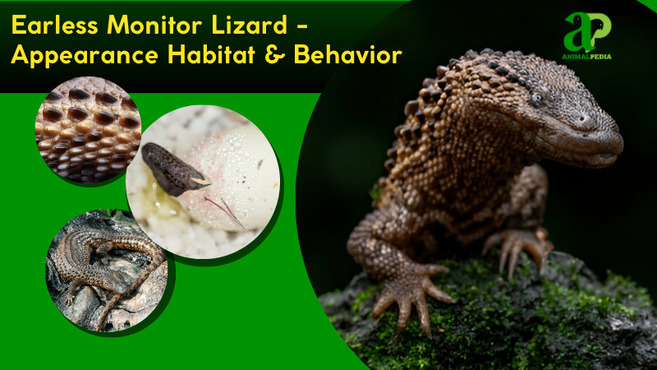Nile monitors (Varanus niloticus) are formidable, semi-aquatic lizards inhabiting diverse African landscapes. These reptiles belong to the family Varanidae, demonstrating their lineage among monitor lizards. Adults commonly span 47-87 inches (120-220 cm) in total length, with weights ranging from 10-20 pounds (4.5-9 kg), making them one of Africa’s most substantial lizard species. Their geographic distribution encompasses sub-Saharan Africa, extending from Senegal to Somalia and Sudan to South Africa, with established invasive populations in Florida, USA (13). These lizards operate as opportunistic carnivores, consuming various invertebrates and small vertebrates (10). Known for their agility, they exhibit impressive terrestrial running speeds of up to 18 mph (29 km/h) and sustained aquatic movement at 3-5 mph (5-8 km/h) (1). They are diurnal, active during the day, and maintain a “Least Concern” conservation status (13).
This Animal Pedia guide explores the Nile monitor’s definition, physical attributes, habitat, behavior, lifecycle, and ecological interactions. Understanding these aspects clarifies the species’ role in native and introduced environments. We begin by defining the Nile monitor.
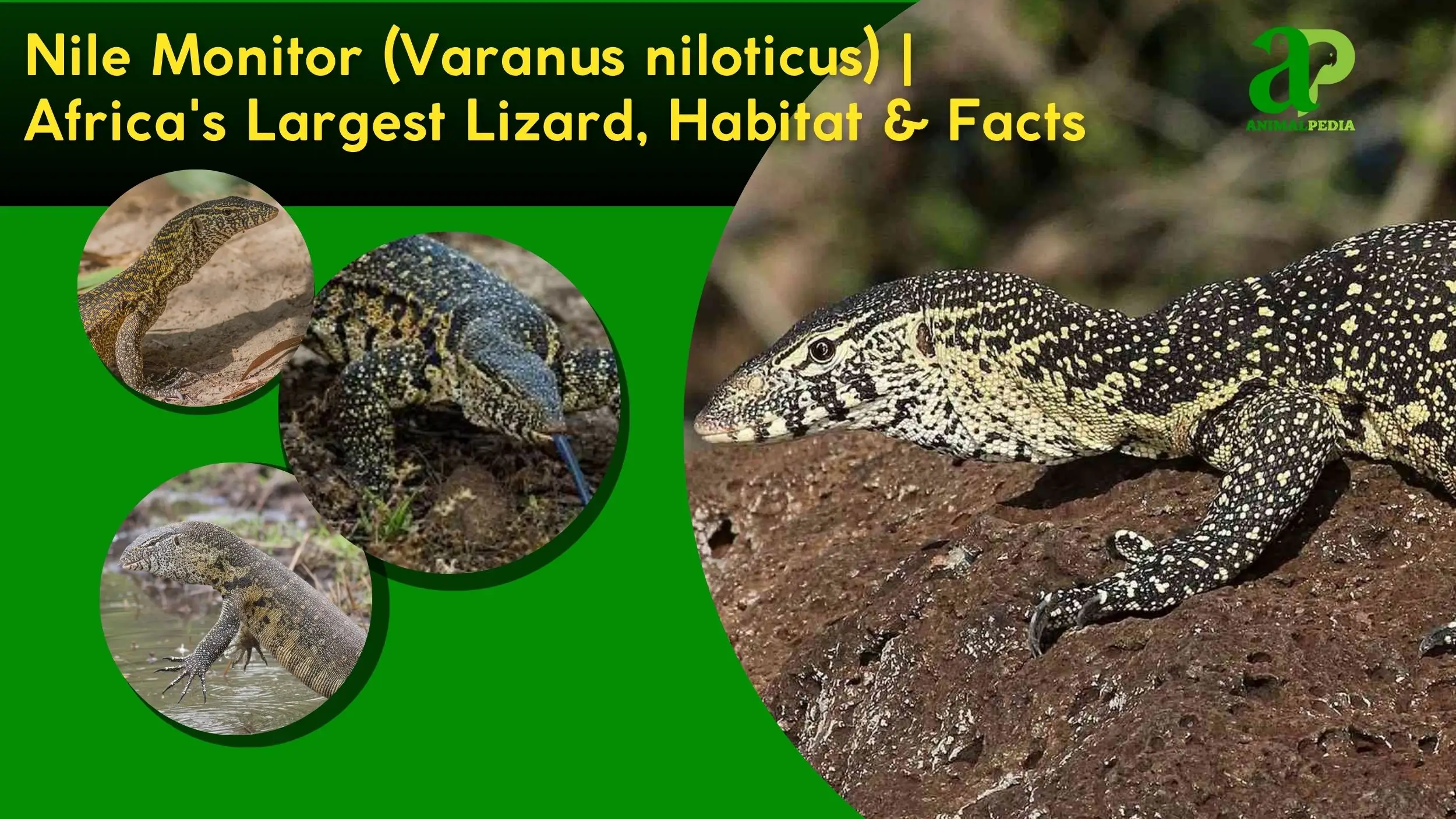
What Is the Nile Monitor?
The Nile monitor possesses a robust, elongated body structured for terrestrial, arboreal, and aquatic locomotion, highlighted by a powerful, muscular build (1). Its overall coloration ranges from gray-brown to olive-black, often displaying darker reticulated patterns that create a net-like design. Adults exhibit 6-9 distinct yellow or golden bands or rings along their backs, while juveniles present more vivid black-and-yellow banding which diminishes with age (3, 13). The skin itself is remarkably scaly and tough, composed of small, bead-like scales that are smooth yet durable, offering protection against predators and abrasion while aiding in thermoregulation (1).
The Nile monitor distinguishes itself through several key physical characteristics, including its distinctive coloration, elongated head, powerful limbs, specialized tail, and unique skin texture. These features collectively contribute to its survival and adaptability across diverse African environments.
Its most prominent features include:
- Robust Body Structure: The Nile monitor’s physique is muscular and powerful, allowing efficient movement across varied terrains and through water (1). The elongated neck, notably longer than the head, enhances its observational capabilities.
- Distinctive Coloration: Adults are typically gray-brown to olive-black with 6-9 striking yellow or golden bands on their backs, providing camouflage in their natural surroundings. Younger individuals feature bold black-and-yellow patterns that offer effective concealment in leaf litter, transitioning to more subdued tones as they mature for blending into aquatic and scrub habitats (1, 13).
- Elongated Head: Characterized by a narrow snout and a conical profile, the head houses a strong skull adapted for crushing prey. The nostrils are small and slit-like, positioned dorsally on the snout, an adaptation for semi-aquatic respiration. The blue-black forked tongue constantly flicks, serving as a primary chemosensory organ for detecting scents (1).
- Powerful Limbs: Equipped with four strong limbs, each ending in five toes bearing large, curved claws that can reach up to 1.2 inches (3 cm) in length (1). These claws are essential for digging burrows, climbing trees and rocks, and securing a grip on prey. The hindlimbs are particularly robust, enabling swift running and jumping.
- Laterally Compressed Tail: A long, whip-like appendage, the tail can measure up to 150% of the snout-vent length and is laterally compressed distally (1, 13). This specialized structure acts as a powerful propeller in water, a counterbalance during climbing, and a formidable defensive weapon capable of delivering forceful whips.
Sexual dimorphism in Nile monitors is minimal; while females may appear slightly smaller, up to 10% shorter during breeding seasons, there are no distinct differences in coloration or anatomical structures between the sexes (1).
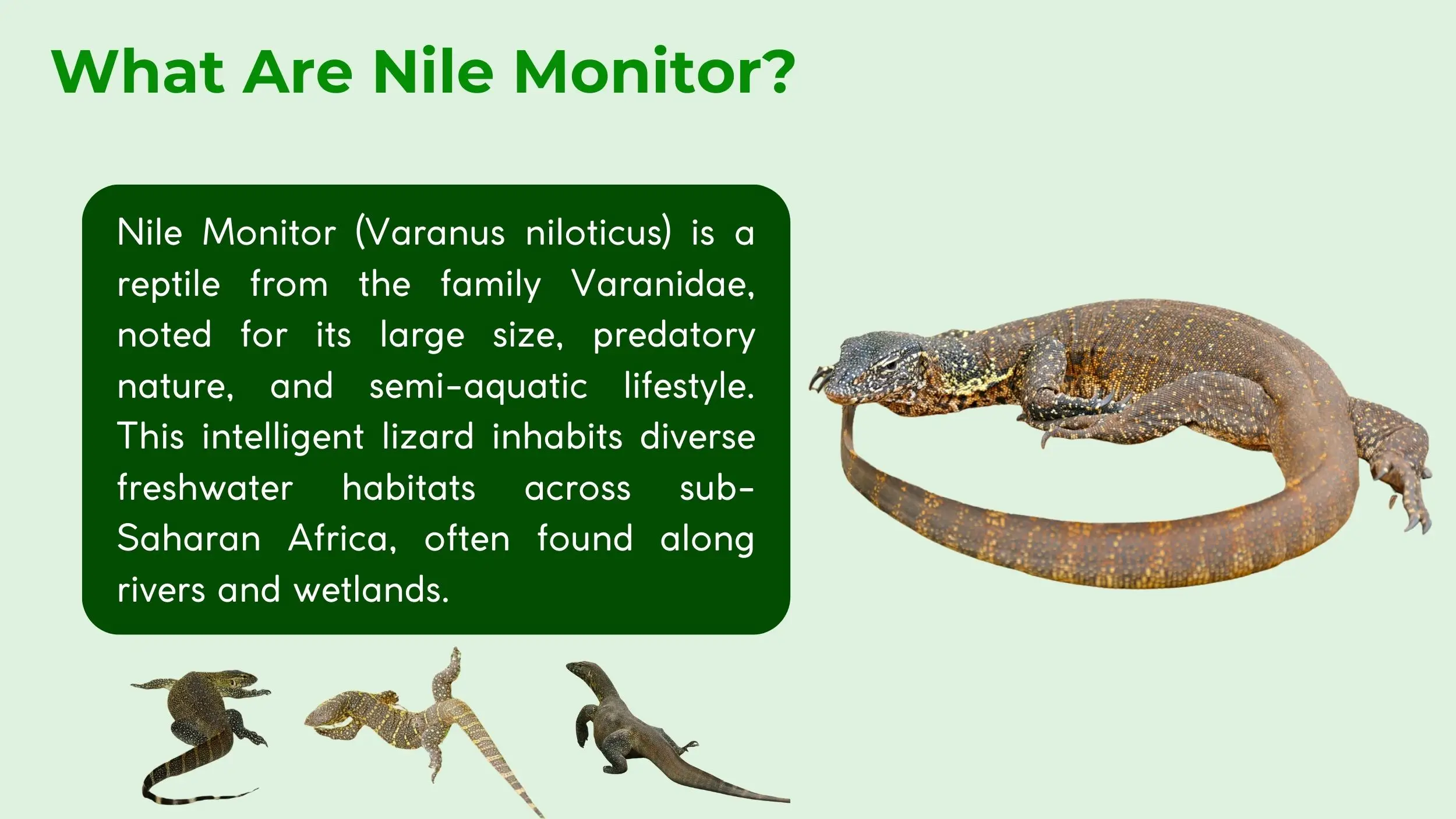
What Does the Nile Monitor Look Like?
The Nile monitor possesses a robust, elongated body structured for terrestrial, arboreal, and aquatic locomotion, highlighted by a powerful, muscular build (1). Its overall coloration ranges from gray-brown to olive-black, often displaying darker reticulated patterns that create a net-like design. Adults exhibit 6-9 distinct yellow or golden bands or rings along their backs, while juveniles present more vivid black-and-yellow banding which diminishes with age (3, 13). The skin itself is remarkably scaly and tough, composed of small, bead-like scales that are smooth yet durable, offering protection against predators and abrasion while aiding in thermoregulation (1).
The Nile monitor distinguishes itself through several key physical characteristics, including its distinctive coloration, elongated head, powerful limbs, specialized tail, and unique skin texture. These features collectively contribute to its survival and adaptability across diverse African environments.
Its most prominent features include:
- Robust Body Structure: The Nile monitor’s physique is muscular and powerful, allowing efficient movement across varied terrains and through water (1). The elongated neck, notably longer than the head, enhances its observational capabilities.
- Distinctive Coloration: Adults are typically gray-brown to olive-black with 6-9 striking yellow or golden bands on their backs, providing camouflage in their natural surroundings. Younger individuals feature bold black-and-yellow patterns that offer effective concealment in leaf litter, transitioning to more subdued tones as they mature for blending into aquatic and scrub habitats (1, 13).
- Elongated Head: Characterized by a narrow snout and a conical profile, the head houses a strong skull adapted for crushing prey. The nostrils are small and slit-like, positioned dorsally on the snout, an adaptation for semi-aquatic respiration. The blue-black forked tongue constantly flicks, serving as a primary chemosensory organ for detecting scents (1).
- Powerful Limbs: Equipped with four strong limbs, each ending in five toes bearing large, curved claws that can reach up to 1.2 inches (3 cm) in length (1). These claws are essential for digging burrows, climbing trees and rocks, and securing a grip on prey. The hindlimbs are particularly robust, enabling swift running and jumping.
- Laterally Compressed Tail: A long, whip-like appendage, the tail can measure up to 150% of the snout-vent length and is laterally compressed distally (1, 13). This specialized structure acts as a powerful propeller in water, a counterbalance during climbing, and a formidable defensive weapon capable of delivering forceful whips.
Sexual dimorphism in Nile monitors is minimal; while females may appear slightly smaller, up to 10% shorter during breeding seasons, there are no distinct differences in coloration or anatomical structures between the sexes (1).
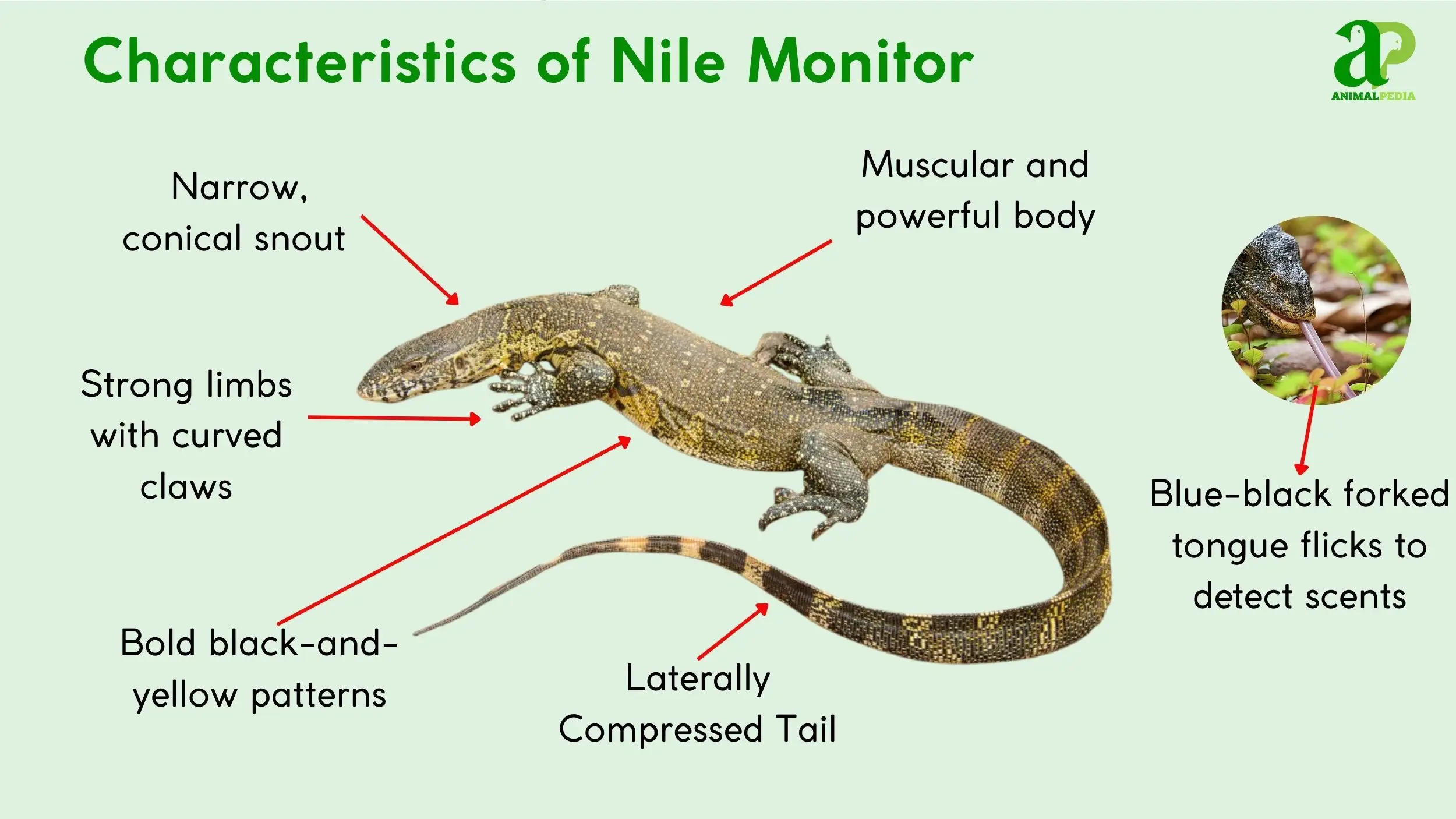
How Big is the Nile Monitor?
Adult Nile monitors typically average 59-71 inches (150-180 cm) in total length, carrying an average weight of 11-15 pounds (5-7 kg) (3). The largest recorded individual reached an impressive 96 inches (244 cm) and weighed 44 pounds (20 kg) (3).
| Trait | Males | Females |
| Length | Up to 96 inches (244 cm) recorded | Up to 87 inches (220 cm) (3) |
| Weight | Up to 44 pounds (20 kg) recorded | Up to 20 pounds (9 kg) (3) |
| Record Size | 96 inches (244 cm), 44 pounds (20 kg) (3) | Up to 10% shorter than males (1) |
Developmentally, hatchlings typically measure 8-12 inches (20-30 cm) in total length and weigh 0.7-1.8 ounces (20-50 g) (1). Juveniles quickly grow to 24-39 inches (60-100 cm) and 2-4 pounds (1-2 kg) by 1-2 years of age (1). They reach sexual maturity at 3-4 years, achieving their full adult size by 5-6 years (1). To visualize their scale, a fully grown Nile monitor can be as long as two standard office desks placed end-to-end.
Understanding the impressive size of the Nile monitor naturally leads to questions about where these remarkable reptiles establish their homes. We now explore the varied habitats they occupy across Africa and beyond.
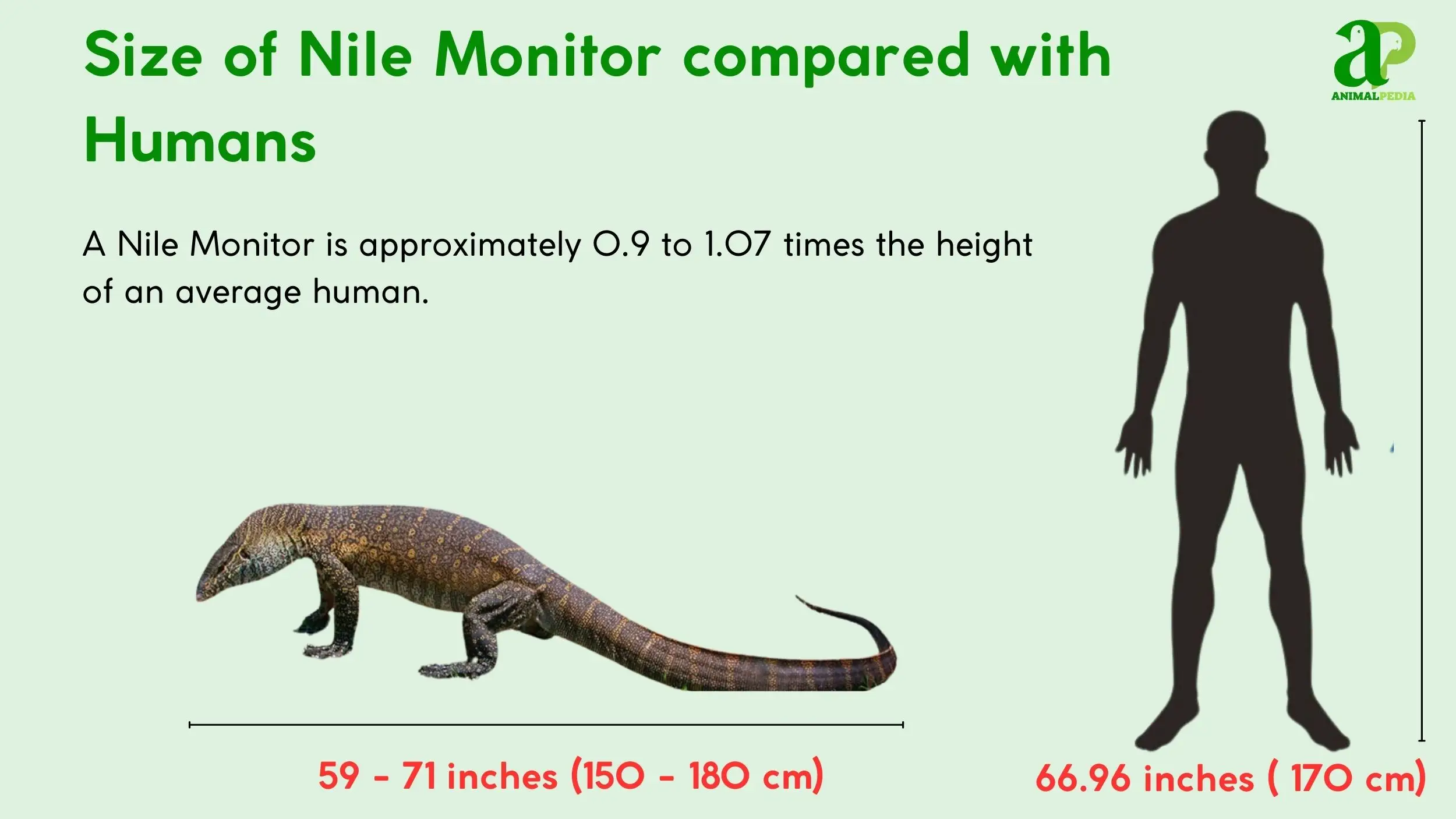
Where Does the Nile Monitor Live?
The Nile monitor primarily inhabits semi-aquatic environments across sub-Saharan Africa, thriving near permanent water sources such as rivers, lakes, and swamps (1, 9, 12). Its vast geographic range spans 33 countries, extending from Senegal in the west to Somalia in the east, and from Sudan southward to South Africa. Beyond its native continent, established invasive populations are present in regions like Florida, USA (13). This adaptability allows them to colonize savannas, woodlands, mangroves, and even urban areas (1, 9, 12).
These reptiles prefer tropical and subtropical climates, with optimal daytime temperatures ranging from 77-95°F (25-35°C) and humidity levels between 60-80% (9, 12). While they tolerate dry seasons, consistent access to water remains critical. Nile monitors are solitary animals, particularly the males, and actively defend their territories. They communicate boundaries and ownership using scent marks from their cloaca or feces, and when challenged, they engage in defensive displays, hissing, and even physical combat (1).
From their preferred aquatic and terrestrial domains, the Nile monitor exhibits fascinating patterns of behavior. Observing their daily activities reveals how these creatures interact with their environment and with each other.
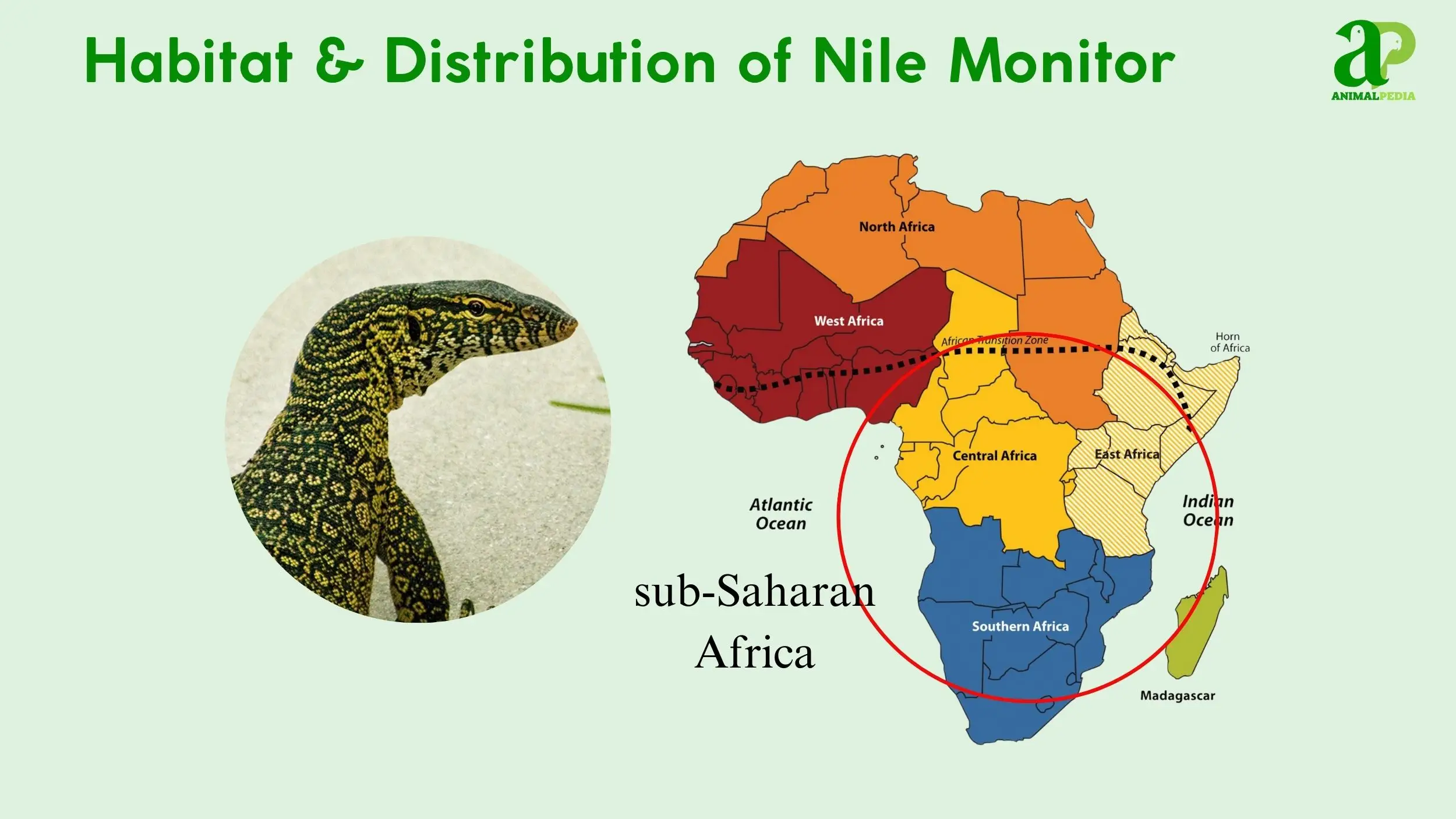
How Does the Nile Monitor Behave?
Nile monitors exhibit a suite of complex behaviors characterized by their active predatory lifestyle, versatile movement across diverse environments, and distinct daily and seasonal activity patterns. Their behavioral repertoire underscores their adaptability as apex predators in African ecosystems.
- Diet and Feeding: Nile monitors are opportunistic carnivores, consuming a wide array of prey, including invertebrates, small vertebrates, and carrion, employing keen senses and ambush tactics (1).
- Movement and Abilities: These lizards are proficient in terrestrial running, powerful swimming using their compressed tail, and agile climbing with strong claws, allowing them to exploit varied ecological niches (1).
- Daily/Seasonal Patterns: Primarily diurnal, Nile monitors spend their days actively foraging and basking, with seasonal patterns often influencing their reproductive cycles and activity levels (1).
This overview of their behavior introduces a closer look at their dietary habits.
Diet and Feeding
The Nile monitor (Varanus niloticus) primarily consumes invertebrates and small vertebrates, functioning as an opportunistic predator and scavenger (1, 10). Their diet typically comprises 50-70% invertebrates, such as crabs and insects, alongside 20-30% small vertebrates like birds, eggs, and other reptiles. Secondary food sources, accounting for approximately 10% of their intake, include carrion, fish, small mammals, and occasional human scraps (1, 10).
Nile monitors are active foragers, utilizing their forked tongue to detect scents over distances up to 328 feet (100 meters) (1). They employ a variety of hunting behaviors, including ambushing prey by digging or climbing. Their powerful jaws can effectively crush the shells of hard-shelled prey like snails and crabs, while sharp, recurved teeth are suited for grasping and tearing flesh (1). This species’ opportunistic feeding patterns allow them to exploit available food resources across their diverse habitats.
Given their predatory nature and formidable jaws, it is natural to question whether the Nile monitor poses a venomous threat. Understanding their defense mechanisms is key to appreciating their interactions.
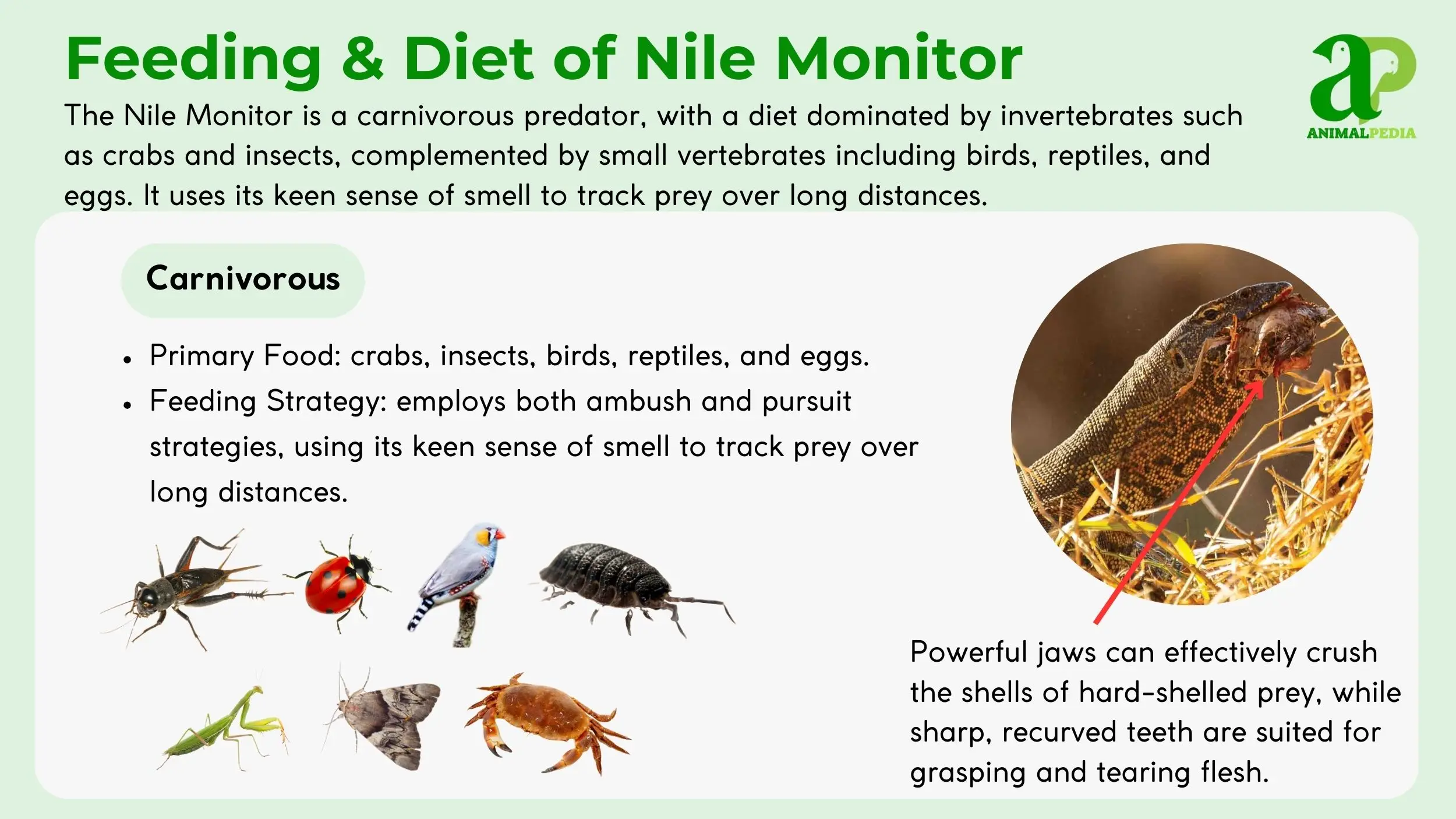
Is Nile Monitor Venomous?
The Nile monitor (Varanus niloticus) is not venomous; its bites cause injury through physical force and the potential for bacterial infection, rather than venomous compounds (1, 13). Bites from a Nile monitor inflict deep puncture wounds and tearing due to their sharp, conical teeth. The primary danger from a bite comes from the bacteria present in their mouths, which can lead to serious infections (1, 13).
If bitten, immediate first aid includes thoroughly washing the wound with soap and water, applying pressure to stop bleeding, and then using antibiotic ointment with a clean bandage (13). Monitoring the wound for signs of infection such as redness, swelling, or fever over 48 hours is essential. Medical attention should be sought for deep wounds, signs of infection, or if tetanus immunization status is unknown; antibiotics such as amoxicillin may be prescribed (13). When confronted, Nile monitors typically attempt to bluff or flee to water. If cornered, they will resort to aggressive defensive behaviors, including hissing, body puffing to appear larger, tail whipping that can cause bruising or fractures, biting, and claw slashing (1). They also emit a foul odor from their cloaca as a stress response (1).
Beyond their dietary habits and defense strategies, the Nile monitor’s impressive agility and diverse methods of movement are central to its survival. Exploring how it navigates its environment reveals its true physical prowess.
Movement and Abilities
Nile monitors (Varanus niloticus) demonstrate versatile movement, excelling in terrestrial running, powerful swimming, and agile climbing (1). Each mode of locomotion is supported by distinct physical adaptations.
- Terrestrial Running: On land, they move with a powerful, undulating gait, capable of swift bursts.
- Swimming: In water, they propel themselves using their laterally compressed tail as a rudder, demonstrating remarkable aquatic endurance.
- Arboreal Climbing: Their strong limbs and sharp, curved claws provide excellent grip for scaling trees and rocky outcrops.
The Nile monitor can run at speeds up to 18 miles per hour (29 km/h) for short distances, covering up to 328 feet (100 m) (1). They maintain a sustainable speed of 5-10 mph (8-16 km/h) over longer distances and are excellent swimmers, capable of sustaining speeds of 3-5 mph (5-8 km/h) indefinitely (1). These physical capabilities are complemented by remarkable special abilities, such as holding their breath underwater for up to 30 minutes while hunting aquatic prey (1). They are considered among the most intelligent reptiles, capable of recognizing individual humans and solving simple puzzles to obtain food (1). Furthermore, their forked, blue-black tongue can detect scents from over 328 feet (100 m) away (1).
The impressive movement and abilities of the Nile monitor are intricately linked to its daily and seasonal rhythms. Understanding when these creatures are most active provides further insight into their behavioral ecology.
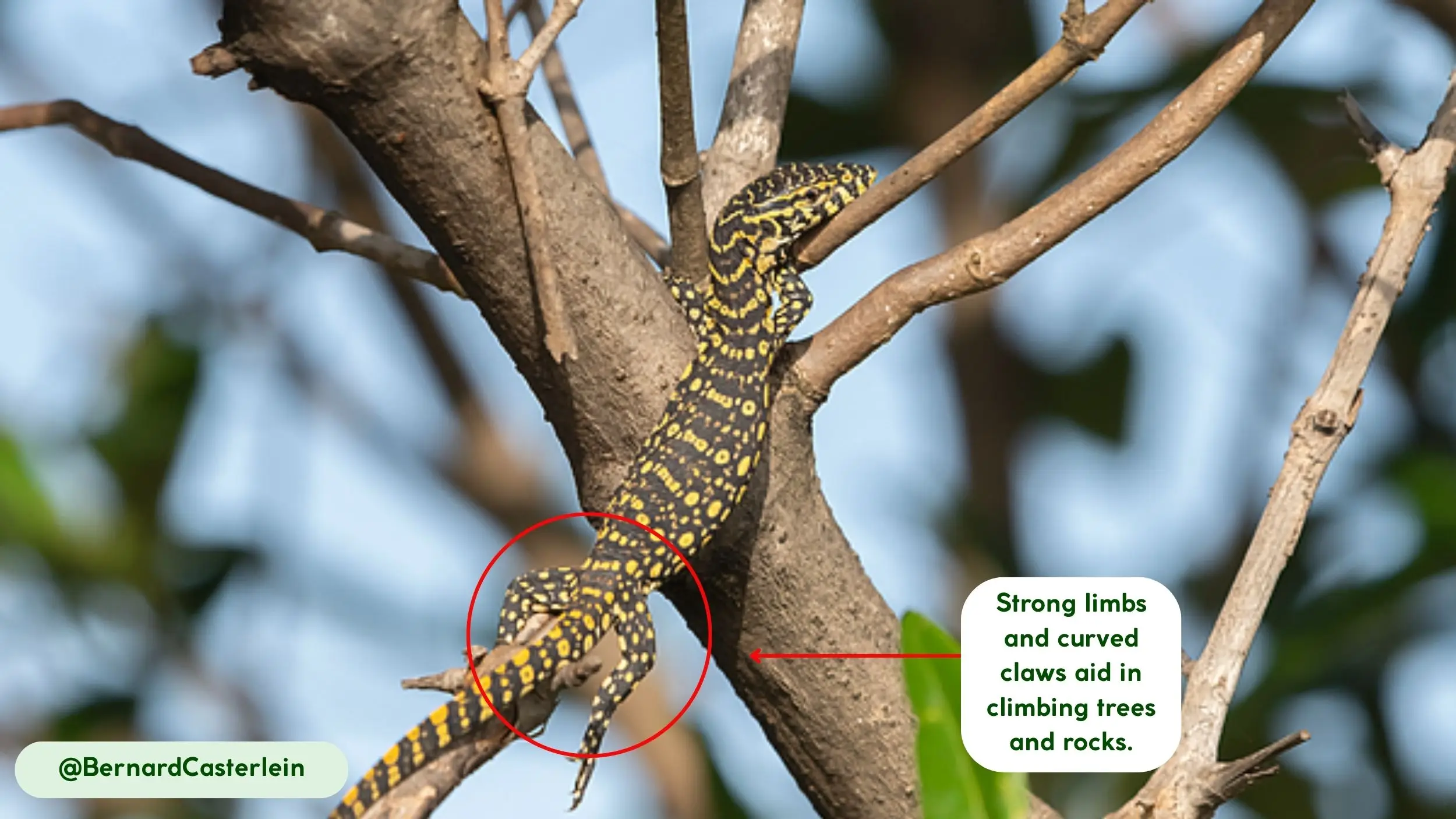
Daily/Seasonal Patterns
Nile monitors are diurnal, commencing activity at sunrise and generally concluding their foraging and basking by late afternoon or early evening (1). Their daily activity cycle is characterized by distinct periods.
- Morning (approximately 6:00 AM – 10:00 AM): Emergence from burrows or basking sites, followed by initial basking to raise body temperature.
- Midday (approximately 10:00 AM – 3:00 PM): Peak foraging activity, involving extensive searching for prey and scavenging.
- Late Afternoon (approximately 3:00 PM – 6:00 PM): Continued foraging, often leading to a final period of basking before retreating to shelter.
While they are active year-round in tropical regions, seasonal patterns influence their behavior (1). During the rainy season (June-October), males engage in courtship, head-bobbing, and chasing females, often involving territorial aggression (1). In temperate areas, such as parts of South Africa, Nile monitors may enter a state of brumation, a reptilian dormancy similar to hibernation, during colder periods (9, 12). This adaptation allows them to survive extended periods of lower temperatures and reduced food availability. Migration is not a typical behavior for Nile monitors; they tend to remain within established territories, though they may shift locales to follow water sources or prey availability (1).
As the seasons influence the daily routines of Nile monitors, they also trigger the vital cycle of reproduction. Exploring their reproductive strategies reveals the delicate processes ensuring the continuation of this fascinating species.
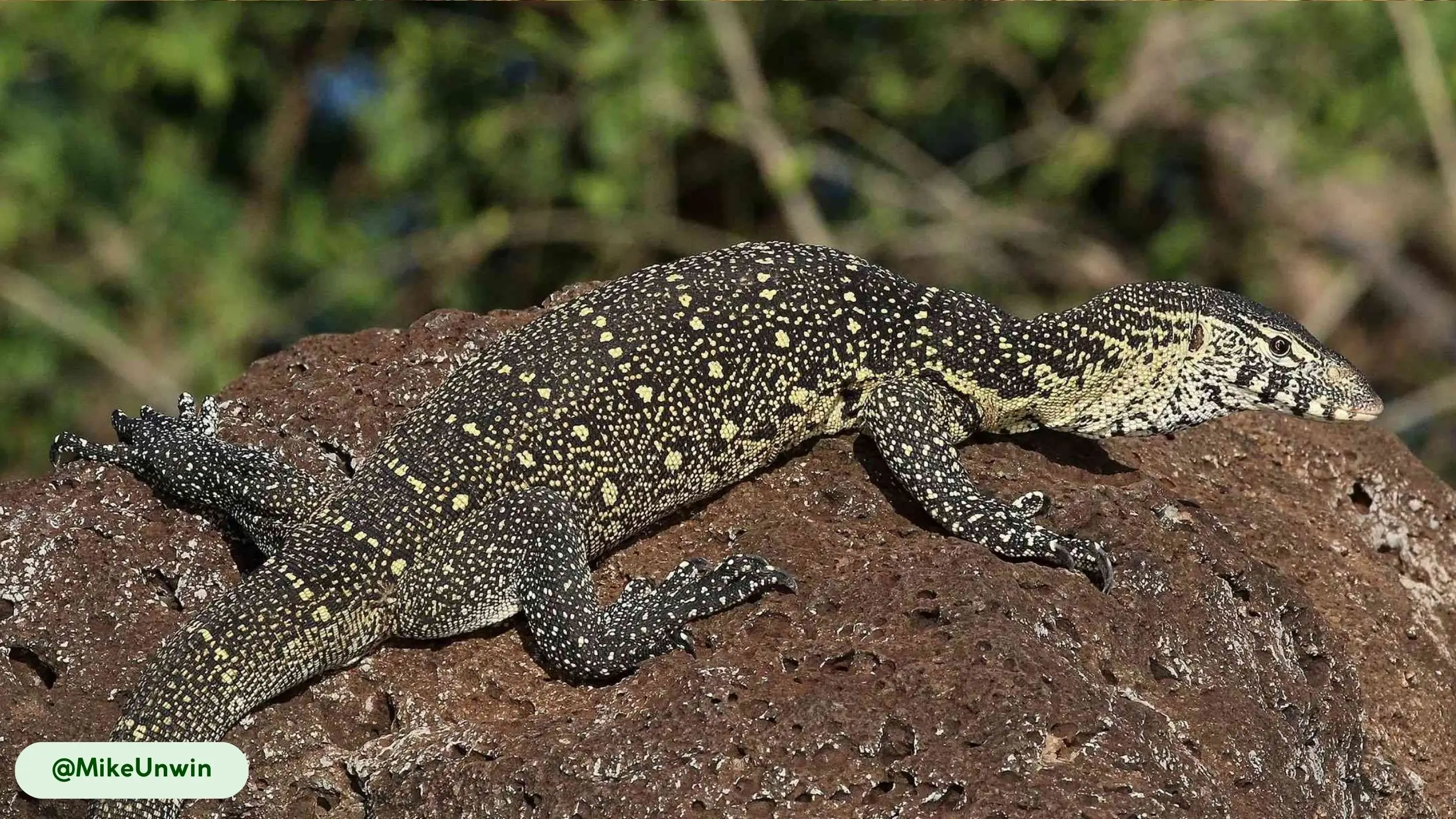
How Does Nile Monitor Reproduce?
Nile monitors (Varanus niloticus) are oviparous, meaning they reproduce by laying eggs (1). Their mating season typically occurs during the rainy season, spanning from June to October (1). Courtship behaviors involve males engaging in head-bobbing displays and chasing females. Territorial aggression between males is common as they compete for mates, often resulting in bites and dominance displays (1).
Following successful mating, females will lay a clutch of 20-60 eggs, with an average of 35-40 eggs (1). These eggs are deposited in buried nests, where they undergo an incubation period of 120-240 days (4-8 months). Temperature-dependent sex determination may influence the sex ratio of hatchlings, with warmer temperatures potentially favoring females (1). Parental care is minimal; females may guard their nests briefly, but they do not provide any post-hatching care for their young (1). These seasonal breeding patterns are primarily triggered by environmental cues associated with the rainy season, ensuring favorable conditions for egg development and hatchling survival (1).
The successful reproduction of Nile monitors contributes directly to their population’s longevity. Understanding how long these lizards typically live offers further insight into their life history and ecological resilience.
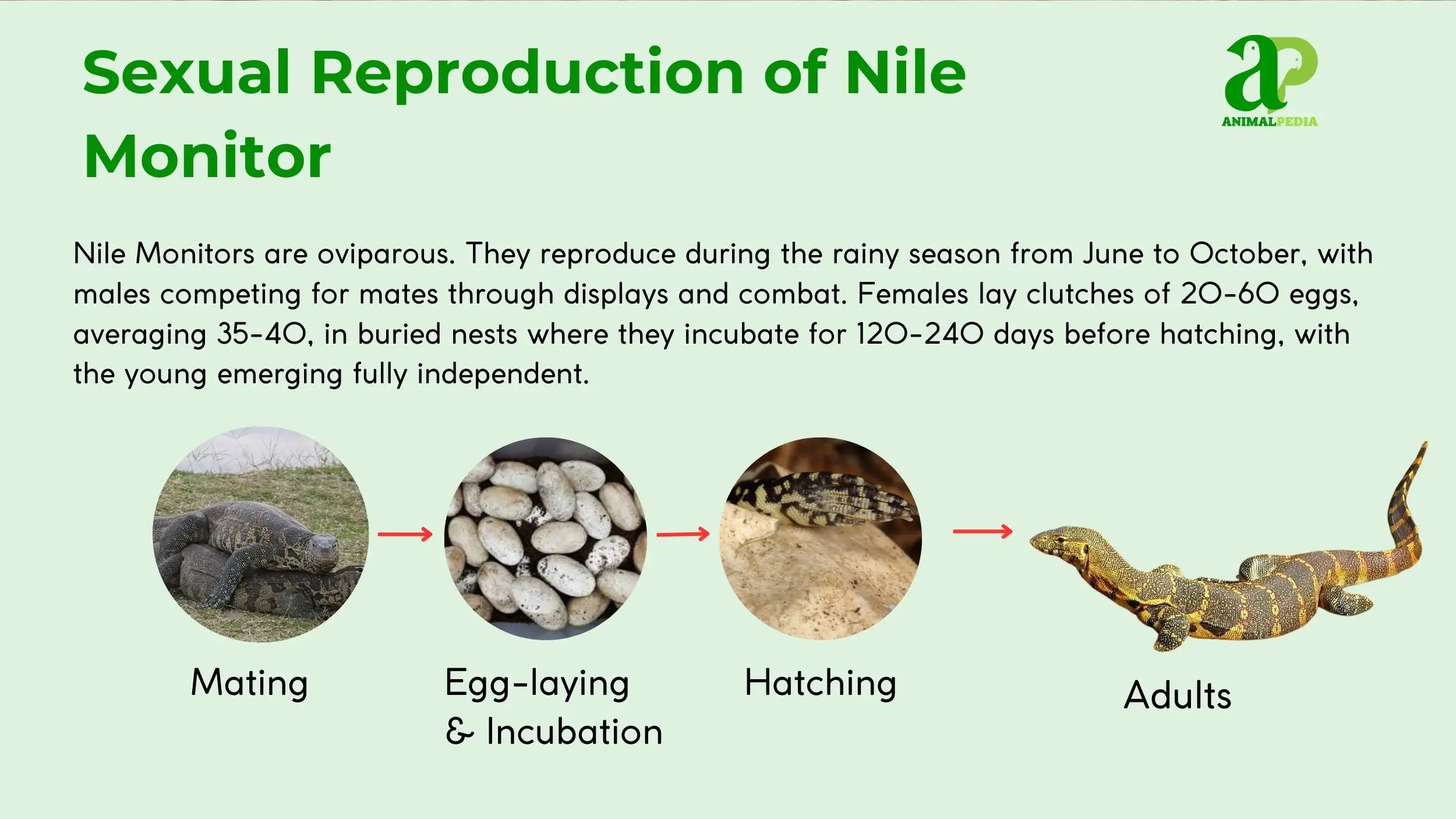
How Long Does the Nile Monitor Live?
Nile monitors (Varanus niloticus) typically live 8-12 years on average in the wild (7). The lifespan of these reptiles varies significantly between wild and captive environments due to differing factors affecting their longevity (7, 10). In their natural habitats, they can survive up to 15 years, while individuals in captivity, under optimal care, may live for 10-15 years, with some reaching up to 20 years (7, 10).
Sexual maturity is achieved at 3-4 years of age, with Nile monitors reaching their full adult size by 5-6 years (1). Several factors influence their longevity. A high-protein diet is crucial for extending life expectancy. Habitat stability also plays a role; while urbanized areas may reduce predation pressure from natural enemies like crocodiles, they can increase exposure to diseases (7). Predation by larger animals, such as crocodiles and pythons, as well as hunting by humans, significantly impacts wild populations. Furthermore, diseases, including parasites like nematodes or bacterial infections resulting from injuries, can reduce their lifespan (7).
Beyond their own survival, Nile monitors play a role in the broader ecosystem, influencing other species and even humans. It is worth exploring how these powerful lizards interact with human populations.
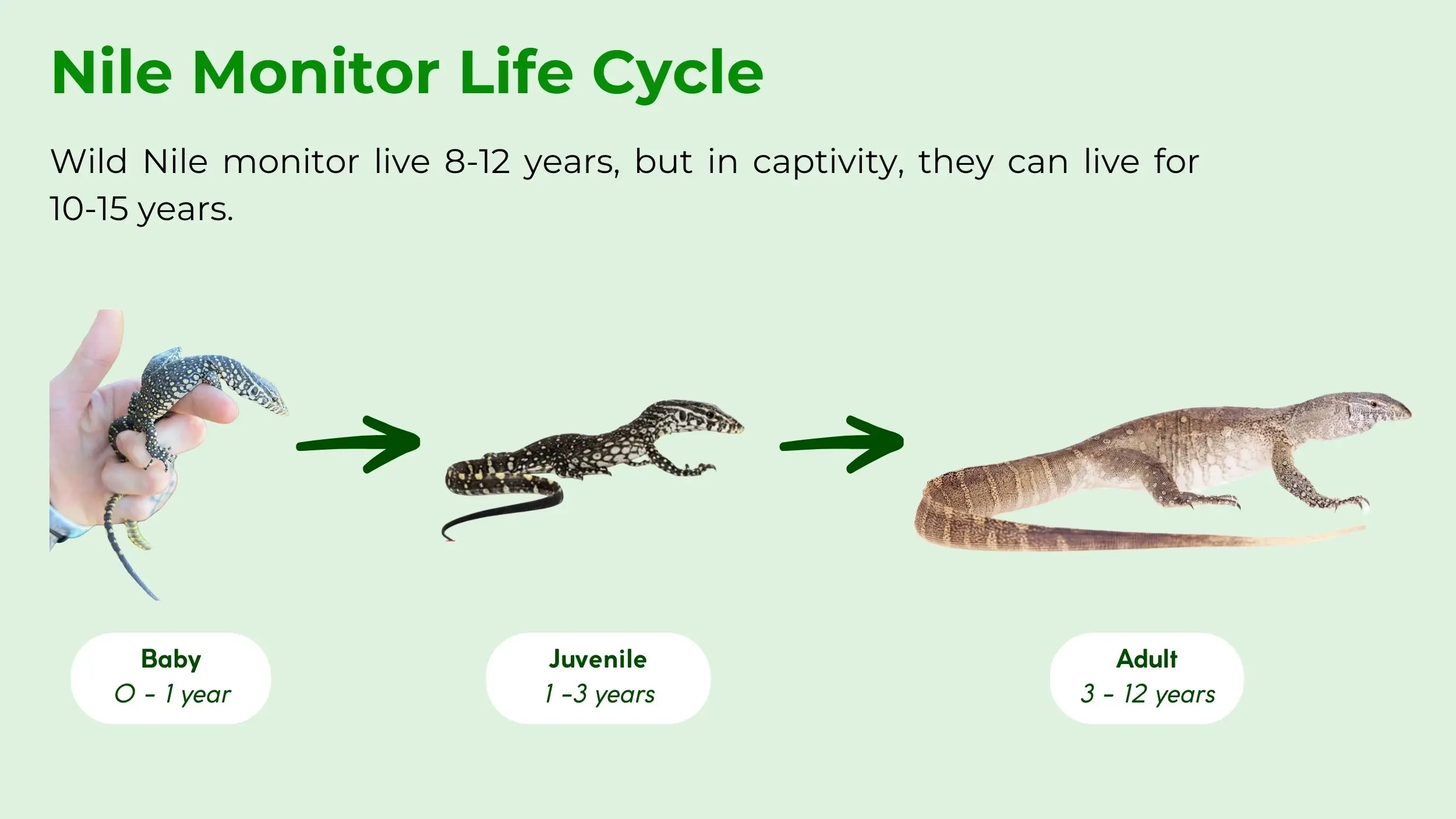
Is Nile Monitor Beneficial to Humans?
Nile monitors (Varanus niloticus) are beneficial to humans primarily in their native African ecosystems through their ecological services, though interactions can also be detrimental (13, 12). They actively control populations of invertebrates and small vertebrates, acting as natural pest controllers in some agricultural areas (1, 12). Furthermore, they scavenge carrion, which helps prevent the spread of diseases within their environment (1). In certain traditional medicine practices across Africa, their fat is believed to cure various ailments and enhance fertility (12, 1). Their presence also contributes to ecotourism in Africa, providing economic benefits to local communities (12). For experienced reptile enthusiasts, they are sometimes kept as pets, albeit challenging ones (13). Culturally, Nile monitors hold significance in African folklore; they are associated with Sobek, the Egyptian crocodile god, symbolizing strength, and are considered sacred in some Nigerian communities for protection rituals, often appearing in mythology as guardians of waterways (12).
Despite their beneficial roles and cultural significance, understanding the conservation status of the Nile monitor is crucial. We now consider if this remarkable species faces threats to its long-term survival.
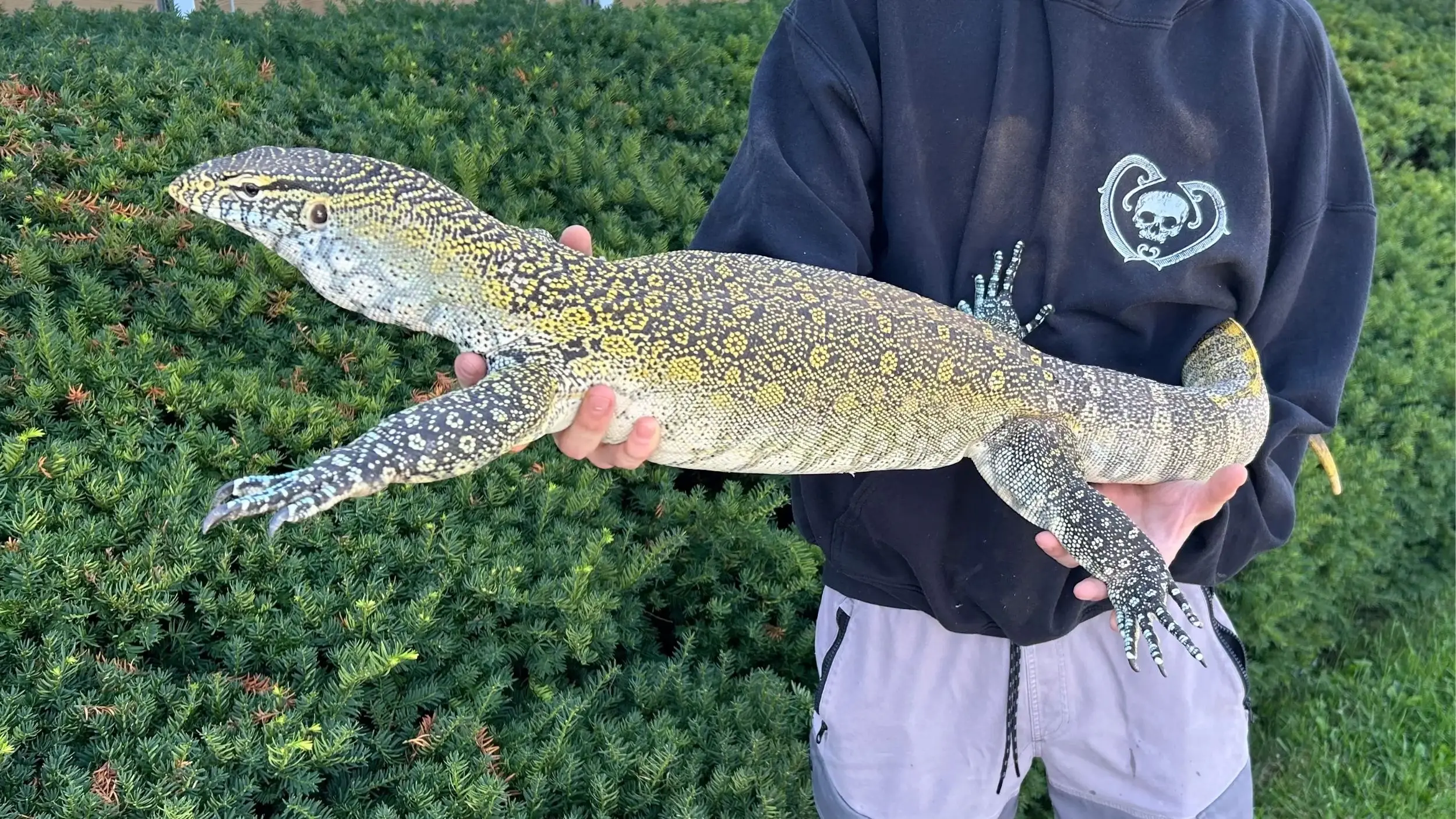
Is the Nile Monitor Endangered?
The Nile monitor (Varanus niloticus) is not endangered; its current conservation status is classified as “Least Concern” by the IUCN Red List, an assessment made in 2019 and remaining stable as of 2025 (13). Despite this status, various threats impact local populations. The main threats include overexploitation for bushmeat and skins, habitat loss resulting from logging and urbanization, and the adverse effects of being an invasive species in non-native ranges (13). As an invasive species, particularly in Florida, they pose significant risks to native wildlife, including endangered burrowing owls, sea turtles, and American crocodiles (6, 13).
In native ecosystems, Nile monitors are ecologically important as crucial top predators and scavengers, maintaining biodiversity and serving as bioindicators for wetland health by accumulating heavy metals (1, 12). Conservation actions include international trade regulation under CITES Appendix II, requiring permits for their movement (13). Protected areas in countries like South Africa and Ethiopia safeguard their habitats (2, 9, 13). Community-based initiatives, such as sacred site restoration in Benin, also contribute to their protection (12). In invasive regions like Florida, monitoring and removal programs actively manage their populations (6, 11).
Having examined the conservation outlook for Nile monitors, it is time to explore some truly captivating details about these reptiles. Their unique characteristics and surprising behaviors make them subjects of continuous fascination.
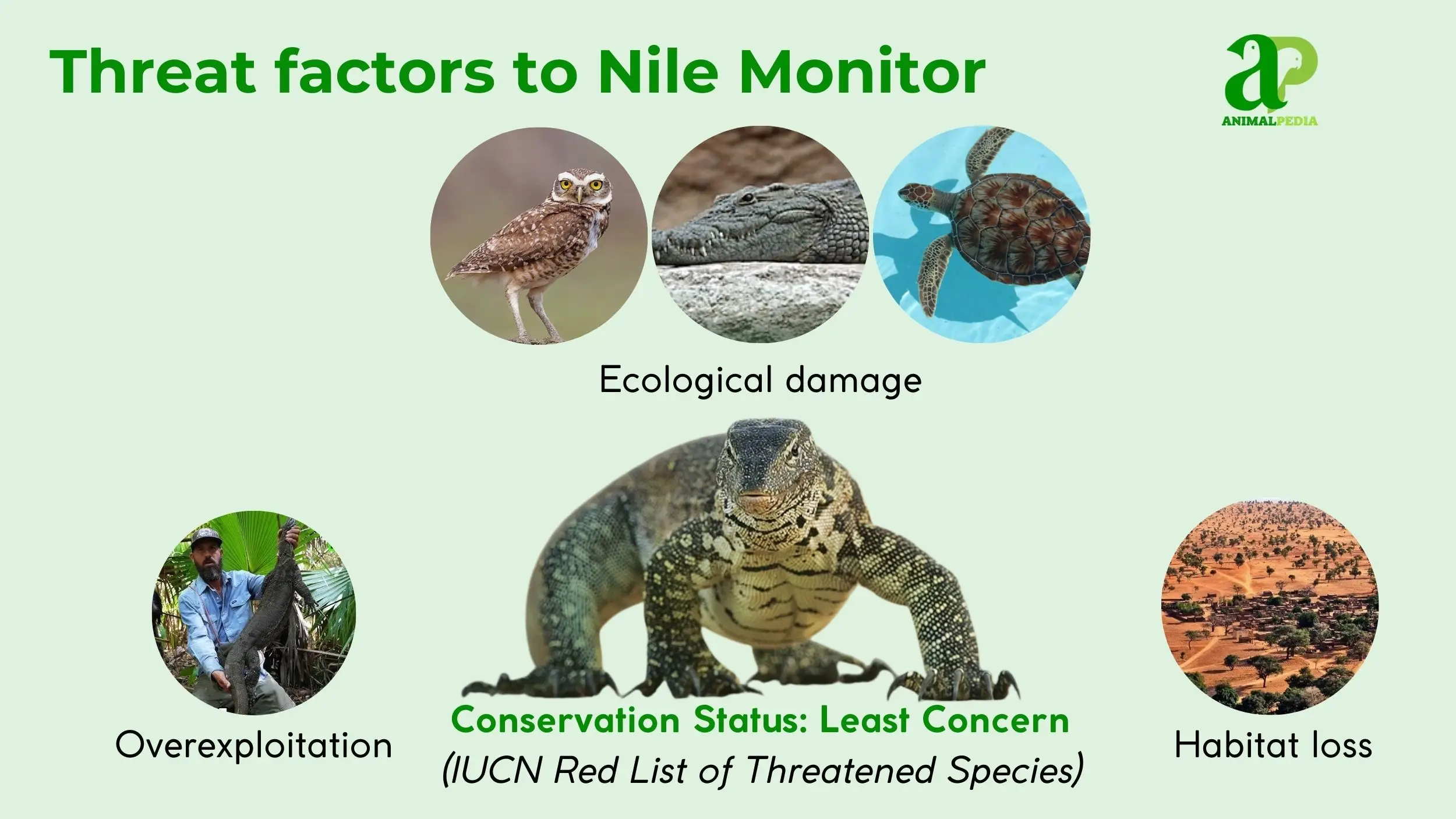
Frequently Asked Questions About Nile Monitor
Are Nile monitors suitable as pets?
Nile monitors are not recommended for beginner reptile keepers due to their aggressive nature and demanding care requirements (13). They grow large and require specialized enclosures, dietary provisions, and advanced husbandry knowledge to thrive, making them suitable only for highly experienced enthusiasts (13).
What is the primary diet of a Nile monitor?
The Nile monitor’s primary diet consists of invertebrates like crabs and insects (50-70%) and small vertebrates such as birds, eggs, and other reptiles (20-30%) (10). They are opportunistic hunters and scavengers, adapting their food intake based on availability (1, 10).
How fast can a Nile monitor run?
A Nile monitor can run at impressive speeds, reaching up to 18 miles per hour (29 km/h) for short bursts (1). This agility on land, combined with their strong swimming abilities, allows them to efficiently pursue prey and escape predators across their varied habitats (1).
Do Nile monitors dig burrows?
Yes, Nile monitors are skilled excavators and frequently dig burrows up to 6.5 feet (2 meters) deep for shelter (1). They also commonly utilize existing structures, such as termite mounds, which they modify to suit their needs for refuge from predators and environmental extremes (1).
How long can a Nile monitor stay underwater?
Nile monitors can remain submerged for a significant period, capable of holding their breath for up to 30 minutes (1). This remarkable adaptation allows them to effectively hunt aquatic prey, ambush unsuspecting targets, and evade threats in their semi-aquatic environments (1).
Conclusion
The Nile monitor (Varanus niloticus) stands as a testament to nature’s adaptive prowess, a large, intelligent lizard that commands respect across its African range. From its distinctive physical features and versatile behaviors to its ecological importance and complex interactions with humans, this species offers a compelling narrative in zoology. Animal Pedia provides comprehensive, scientifically accurate insights into the world of animals, bridging the gap between intricate biological details and accessible knowledge. We invite you to explore our vast collection of animal profiles and deepen your understanding of Earth’s diverse fauna. Expand your horizons and continue your journey of discovery with Animal Pedia.

